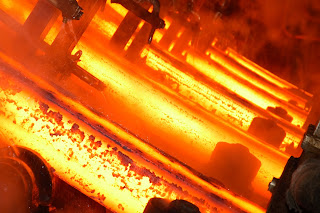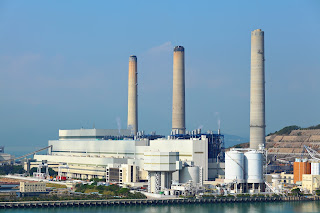 |
| View of the inside of a shell and tube heat exchanger shows the tubes through which one of the transfer fluids passes. |
A common design of heat exchangers used in the oil refining and chemical processing industries is the shell and tube heat exchanger. A pressure vessel, the shell, contains a bundle of tubes. One fluid flows within the tubes while another floods the shell and contacts the outer tube surface. Heat energy conducts through the tube wall from the warmer to the cooler substance, completing the transfer of heat between the two distinct substances. These fluids can either be liquids or gases. If a large heat transfer area is utilized, consisting of greater tube surface area, many tubes or circuits of tubes can be used concurrently in order to maximize the transfer of heat. There are many considerations to take into account in regards to the design of shell and tube heat exchangers, such as tube diameter, circuiting of the tubes, tube wall thickness, shell and tube operating pressure requirements, and more. In parallel fashion to a process control system, every decision made in reference to designing and practically applying the correct heat exchanger depends on the factors present in both the materials being regulated and the industrial purpose for which the exchanger is going to be used.
 |
| Schematic of shell and tube heat exchanger |
The industrial and commercial applications of shell and tube heat exchangers are vast, ranging from small to very large capacities. They can serve as condensers, evaporators, heaters, or coolers. You will find them throughout almost every industry, and as a part of many large HVAC systems. Shell and tube heat exchangers, specifically, find applicability in many sub-industries related to food and beverage: brewery processes, juice, sauce, soup, syrup, oils, sugar, and others. Pure steam for WFI production is an application where special materials, like stainless steel, are employed for shell and tube units that transfer heat while maintaining isolation and purity of a highly controlled process fluid.
Shell and tube heat exchangers are rugged, efficient, and require little attention other than periodic inspection. Proper unit specification, selection, and installation contribute to longevity and solid performance.
Analynk Wireless manufactures wireless connectivity solutions for industrial applications and process control. Making cable free connections among process control equipment and instruments, across the room, across the property, across the globe.




